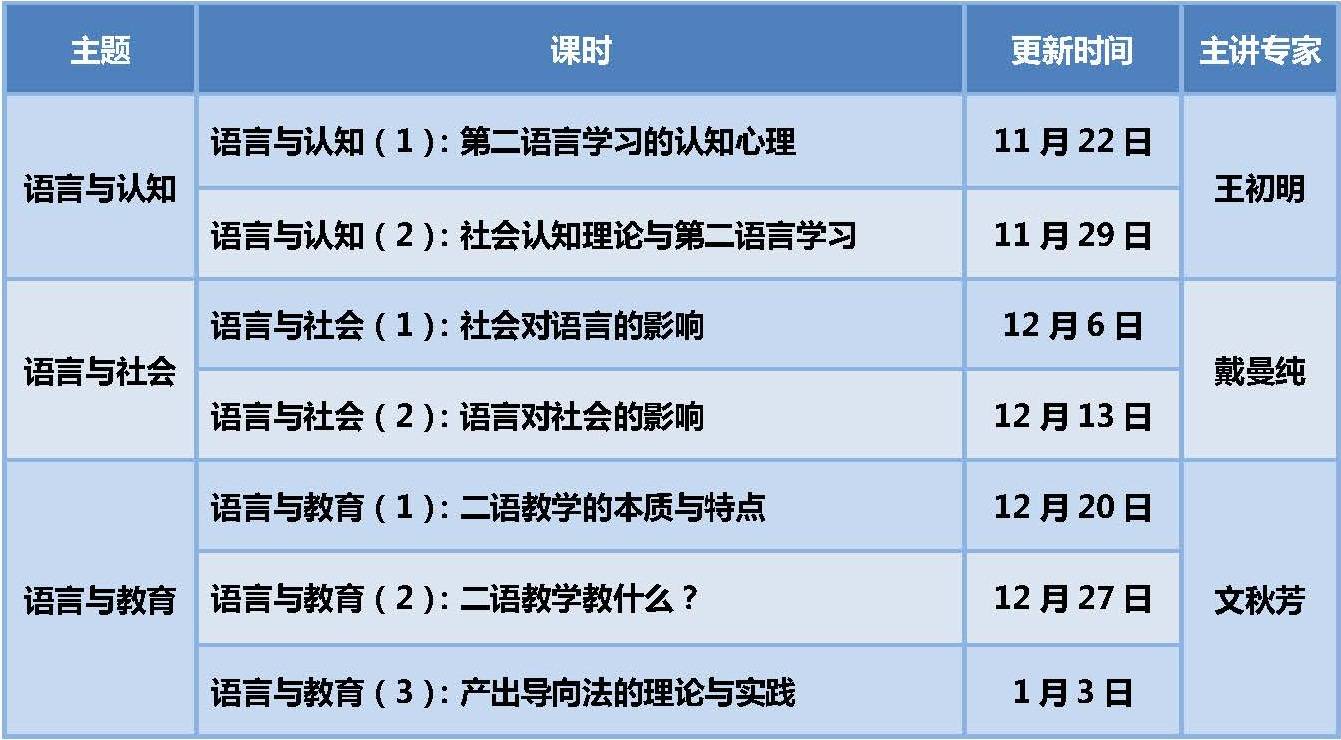参加微博互动,直击研修现场 进行中
【课程目录&课程视频更新计划】
课程视频已全部上线,祝您学习愉快!

【授课语言】
本课程授课语言为中文,各语种学习者、研究者均可加入本课程的学习。
【课程特色】
权威性:北京外国语大学中国外语与教育研究中心、许国璋语言高等研究院外国语言学及应用语言学专业精品课程;应用语言学领域权威专家担任主讲
系统性:课程内容科学系统,全面阐释语言与认知、语言与教育的关系及与之相关的核心理论与问题
前沿性:课程涵盖核心理论的同时,探讨语言与认知及语言与教育领域前沿研究成果及研究热点,帮助学习者发展自己的研究方向
【课程目标】
如果您是语言教师,通过本课程的学习,您将:
1.深入了解应用语言学这一研究领域,通过对语言与认知、语言与教育相关理论及研究方向的学习,发展自己的研究选题、形成研究设计;
2.全面理解语言与认知、语言与教育的关系及与之相关的理论,助力语言教师优化教学方法、提升教学效果
如果您是语言专业或应用语言学方向的学生,通过本课程的学习,您将:
1.深入了解应用语言学这一研究领域,通过对语言与认知、语言与教育相关理论及研究方向的学习,发掘自己具体的研究方向及论文选题,并撰写出应用语言学研究相关的学术论文
2.从认知与教育的角度更全面地看待和理解语言学习,培养更科学、高效的语言学习策略
【证书机制】

【适合人群】
1. 外语教师,尤其是对应用语言学、二语习得、语言与认知、语言与教育等感兴趣的教师或研究者;
2. 研究方向为应用语言学的高年级本科生及研究生;
3. 对应用语言学感兴趣的任何学习者。
【推荐阅读】
Atkinson, D. 2011. Alternative approaches to second language acquisition. Abingdon: Routledge.
Atkinson, D. 2014. Language learning in mindbodyworld: A sociocognitive approach to second language acquisition. Language Teaching, 47, 467-483.
Ellis, N. C. 2006. Selective attention and transfer phenomena in SLA: Contingency, cue competition, salience, interference, overshadowing, blocking and perceptual learning. Applied Linguistics, 27, 164-194.
Ellis, R. 2016. Focus on form: A critical review. Language Teaching Research, 20, 405-428.
Eskildsen, S. W. 2012. L2 negation constructions at work. Language Learning 62, 335-372.
Goldberg, A. E. 2006. Constructions at work. New York: Oxford University Press.
Jarvis, S. & Pavlenko, A. 2008. Crosslinguistic influence in language and cognition. New York: Routledge.
Mitchell, R., Myles, F. and Marsden, E. 2013. Second language learning theories. 3rd edition. London: Routledge.
Odlin, T. 2005. Crosslinguistic influence and conceptual transfer: What are the concepts? Annual Review of Applied Linguistics, 25, 3-25.
Pavlenko, A. 1999. New Approaches to concepts in bilingual memory. Bilingualism, Language and Cognition, 2, 209-230.
Pawley, A., & Syder, F. 1983. Two problems for linguistic theory: Nativelike selection and native like fluency. In J. Rochards & R. Schmidt (Eds.), Language and communication. London: Longman.
Pickering, M. J., & Garrod, S. 2004. Toward a mechanistic psychology of dialogue. Behavioral and Brain Sciences, 27, 169-226.
Robinson, P. (Ed.). 2001. Cognition and second language instruction. Cambridge: Cambridge University Press.
Robinson, P. & Ellis, N. C. 2008. Handbook of cognitive linguistics and second language acquisition. NY: Routledge.
Slobin, D. 1996. From “thought and language” to “thinking for speaking”. In Gumperz, J. and Levinson, S. (Eds.) Rethinking linguistic relativity. Cambridge: Cambridge university Press.
Tyler, A. 2010. Usage-based approaches to language and their applications to second language learning [J]. Annual Review of Applied Linguistics, 30, 270-291.
Tomsello, M. 2003. Constructing a language: A usage-based theory of language acquisition [M]. Cambridge, Mass.: Harvard University Press.
Tomasello, M. 2000. First steps toward a usage-based theory of language acquisition. Cognitive Linguistics, 11, 61-82.
The“Five Graces Group”. 2009. Language is a complex adaptive system: position paper. Language Learning, 59, 1-26.
Trofimovich, P. & Kennedy, S. 2014. Interactive alignment between bilingual interlocutors: Evidence from two information-exchange tasks. Bilingualism: Language and Cognition, 1-14.
Wang, C. & Wang, M. 2015. Effect of alignment on L2 written production. Applied Linguistics, 36, 503-526.
Yu, L. & Odlin, T. 2015. New perspectives on transfer in second language learning. Bristol: Multilingual Matters.